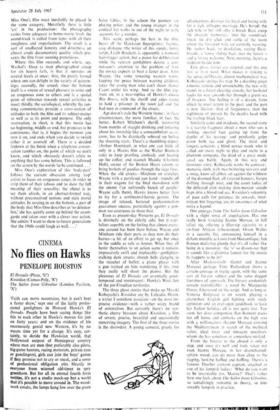Rear guard
ART MARIO AMAYA
T9 make a movie of 365 naked bottoms might sound a boring venture even to the most call- pygian minded. Yoko Ono's much publicised film, No 4, which opens at the Jacey-Tatler (Charing Cross Road) on 8 August with a bene- fit performance for the Institute of Contempor- aszy Arts, is composed of nothing save the above-mentioned bottoms. But curiously enough this ninety-minute effort is not the least bit bor- ing, proving the point that the most drastic limitations of subject matter never make a work of art either exciting or dull; it is all a question of how they are handled (after all, Morandi painted nothing but bottles most of his life).
The bottoms in No 4 switch about every fif- teen seconds. There is no shift of focus or change of lighting and they are seen close up so that the rectangle of the screen frames what is roughly a division into four quarters made by two cheeks meeting the beginning of the limbs. This basic pattern is relieved either dramatically or subtly by the concavity of the anal area and the way the legs fit into the torso. The overriding design is a strong vertical divi- sion bisected by a more delicate, horizontal one that depends on firmness, roundness and mus- cularity—or the lack of it. Superimposed on this structure is an incredible variety of textures such as smooth, rough, hirsute, etc. Still, ninety minutes is a long time. But unlike Andy, War- hol's film studies of boredom, with which Miss Ono's singular essay must inevitably be com- pared (it is said that Warhol once planned a movie of nothing but breasts, but decided it was too limiting), she and her director-producer hiisband Tony Cox have increased visual in- terest by setting the subject in motion. This is done by placing the cast one by one on a mov- ing treadmill. Moreover, they have collaged together a sound track made up of conversa- tions, remarks, wisecracks, protests, and discus- sions taped before, during and after the filming.
Just as Warhol's products cannot really be seen in the regular context of fine art, but rather as social phenomena—statements that relate directly to. human behaviour, tolerance levels and psychological predicaments—so
Miss Ono's film must inevitably be placed in the same category. Mercifully there is little `art' in the production: the photography varies from adequate to home-movie level; the sound-track is culled from tapes with all their roughness and imperfections. The result is a sort of unaffected honesty and directness, an almost crude documentary quality which pre- vents the film from seeming pretentious.
Where this film succeeds, and where, say, Warhol's Sleep (a man photographed asleep for six hours) fails, is that it operates on several levels at once: first, the purely formal where one can delight in the variety of pattern- ings; secondly, the sexual, since the bottom itself is a source of sexual pleasure to some and an erogenous zone to others and is a spatial point of reference towards sexual activities to most; thirdly, the sociological, whereby the run- ning commentaries provide a cross-section of attitudes to both the film and its subject-matter as well as to its point and purpose. The only reservation, in short, is that this movie has no beginning, middle or end, but proposes to be continuous; that is, it begins the moment you turn it on, and ends when you decide to switch either it or yourself off. There is a decided letdown at the finish when a telephone conver- sation rambles on, the point of which we don't know, and which obviously doesn't relate to anything that has come before. This is followed on the screen by the words `to be continued... .'
Miss Ono's exploration of this 'body-part' follows the current obsession among 'cop' artists to focus on erogenous zones, in order to strip them of their taboos and to show the full meaning of their sexuality; the object is to see them afresh, in an abstract-formal way, without preconceived notions and stale moral attitudes. In zeroing in on the bottom, a part of the body that Miss Ono describes as `so defence- less,' she has quietly come up behind the avant- garde and taken over with a clever rear action. She admits 'I want to show to future generations that the 1960s could laugh as well... .'































 Previous page
Previous page